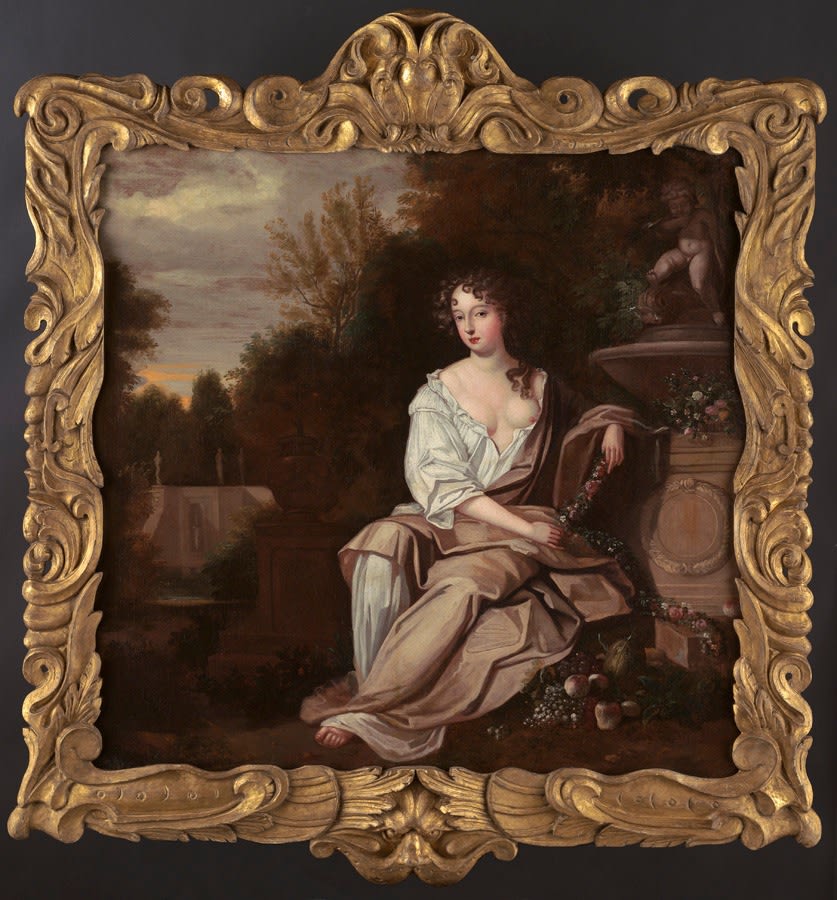
Studio of Sir Peter Lely
To view all current artworks for sale visit philipmould.com
‘Pretty witty Nell’ was, according to Samuel Pepys, ‘brought up in a bawdy-house to fill strong water to the guests.’ That she became Charles II’s most famous and popular mistresses is testament to her achievement in overturning convention, taste and class rigidity in a court system famed for its inflexibility. Though she admittedly became the priapic King’s mistress at a time when ‘whoreing was in fashion’ – as she herself reportedly put it – Gwynn helped establish the acceptability of mistresses amongst royalty, a tradition that has never entirely been discarded. She entered the popular consciousness through her impudence and humour, which in turn has animated history’s image of Charles II''s court.
The anecdotal history of Nell Gwynn is filled with episodes that endeared her to the public of her time, who resented the grand manner of her rival, Louise de Kerouaille, the detested ''Madam Carwell.'' Most notable among these is her rebuke to an angry mob at Oxford who mistook Nell’s carriage for that of the Frenchwoman: ''Good people be civil. It is the Protestant whore.'' Equally legendary is the incident in which she addressed her son Charles Beauclerk as a ''bastard'' in front of Charles II, and met the rebuke by saying that she had no other name by which to call him. Beauclerk was instantly declared Earl of Burford, and later became Duke of St Albans. He was the last of Charles's sons to receive a Dukedom, and this lesser treatment highlights the difference in station between Nell Gwyn and her well-born rivals. It was intended that Nell be created Countess of Greenwich -the other women were made Duchesses- but Charles died before the patent could be drawn up. Even the King's deathbed words indicate this difference in rank, in which he asked his brother ''to be well to Portsmouth'' (Kerouaille) and ''Let not poor Nelly starve.'' James II was true to this wish, and her debts were paid out of the secret service moneys. She died of apoplexy in 1687, when she was about thirty-six.
The iconography of Nell Gwynn is notoriously confused. Her increasing fame, particularly in the eighteenth and nineteenth centuries, saw portraits of dull and innocent ‘beauties’ transformed, with the simple addition of a new label, into the most famous mistress in British history. In reality, however, there were relatively few portraits of Gwynn painted during her lifetime. Her fame as an untitled courtesan of lowly status did not translate, amongst her contemporaries at least, into a desire to hang her portrait on their walls. While there were, for example, thirteen of the Duchess of Cleveland in Lely’s posthumous studio sale, there were none of Gwynn.
This portrait, however, stands out from the usual canon of mis-identified ‘Nell Gwynns’, and can be certainly identified as her. It derives from a lost painting by Lely from about 1675, of which two studio versions are known to survive, the best of which is in the National Portrait Gallery. This work was engraved by Gerard Valck. Both the print and the NPG Lely studio work differ from the present picture, which contains a broad arcadian landscape of gardens, waterfalls, lit by a sunset, in which Nell lies lazily in the foreground. Here the emphasis is on the sexual availability of the sitter. The formality of costume and contrived postures found in Lely’s more usual compositions has been replaced by the most revealing full-frontal appearance that this format will allow.
The bared breasts are of great significance for purposes of identity. Catherine MacLeod notes in ‘Painted Ladies, Women at the Court of King Charles II’, that portraits by Lely showing bare breasts ‘seem exclusively to depict mistresses.’ Though it is an inexact science, the level of décolletage in Stuart portraits tends to increase in proportion to the sitter’s sexual availability. This, in turn, was dependent on a complex combination of class, politics, and, of course, looks. Such a brash gradation (or degradation) of sexual worth can be seen in Lely’s portraits of royal mistresses such as Mary Davis, and that formerly called the Duchess of Portsmouth, now thought to be Mrs Hughes, mistress of Prince Rupert. Only a sitter relaxed about her status, and unconcerned about both her class background and received social etiquette, would consent to being painted in this manner.
Sir Peter Lely’s character and talent dominated the art world of the second half of the seventeenth century in England. Though Pepys famously described him as ‘a mighty proud man and full of state’, Lely’s skill for portraiture meant he assumed the mantle of Sir Anthony van Dyck with ease. Despite sharing the stage with many accomplished painters, the particular brio of his technique and his considerable personal charm guaranteed him the most prestigious patronage. Everyone of consequence in his age sat to him, and it is in his portraits that we form our conception of the cautious solemnity of the 1650s and the scandalous excesses of the years following the Restoration.
Provenance
Collection of the Earls of Berkeley, Berkeley Castle and formerly at Cranford House ;Sold by the Earl of Berkeley in 1946;
Gloucestershire Private Collection.
Be the first to hear about our available artworks
* denotes required fields
We will process the personal data you have supplied in accordance with our privacy policy (available on request). You can unsubscribe or change your preferences at any time by clicking the link in our emails.